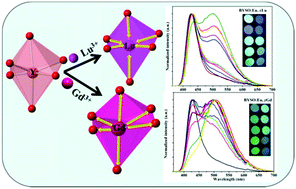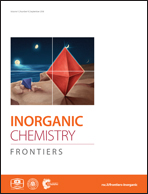Control of the photoluminescence in Ba0.97Y2Si3O10:Eu2+ phosphors via the intensification effect of the second luminescence centre†
Abstract
Cation substitution has been proven to be a prevailing strategy for efficiently tuning the luminescence properties of divalent europium (Eu2+). In this work, the isostructural Ba0.97Y2−xLuxSi3O10:0.03Eu2+ (BYSO:Eu,xLu) and Ba0.97Y2−yGdySi3O10:0.03Eu2+ (BYSO:Eu,yGd) (x/y = 0.00–2.00) solid solutions with two emission bands were designed based on the existence of a second potential luminescence center in the Ba0.97Y2Si3O10:0.03Eu2+via the conventional solid-state reaction. Combined with the variation of distortion and disorder, a new model named the intensification effect of the second luminescence center was built in view of the local and average structures. All the samples exhibit a series of asymmetric and broad-band emissions covering the blue and cyan or blue and green regions, due to the increased Eu2+ amounts in the second coordination zone, which is attributed to the increase in distortion and disorder by varying the Gd3+ or Lu3+ content. Moreover, the thermal properties of BYSO:Eu,yGd are superior to the commercial BaMgAl10O17:Eu2+, with T1/2 over 523 K and small reductions in emission intensity at 423 K. The present research aims to shed new light on the improvement of phosphor properties with broad-band emission and high luminous efficacy.



 Please wait while we load your content...
Please wait while we load your content...